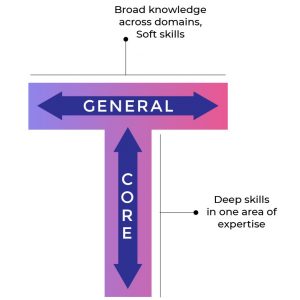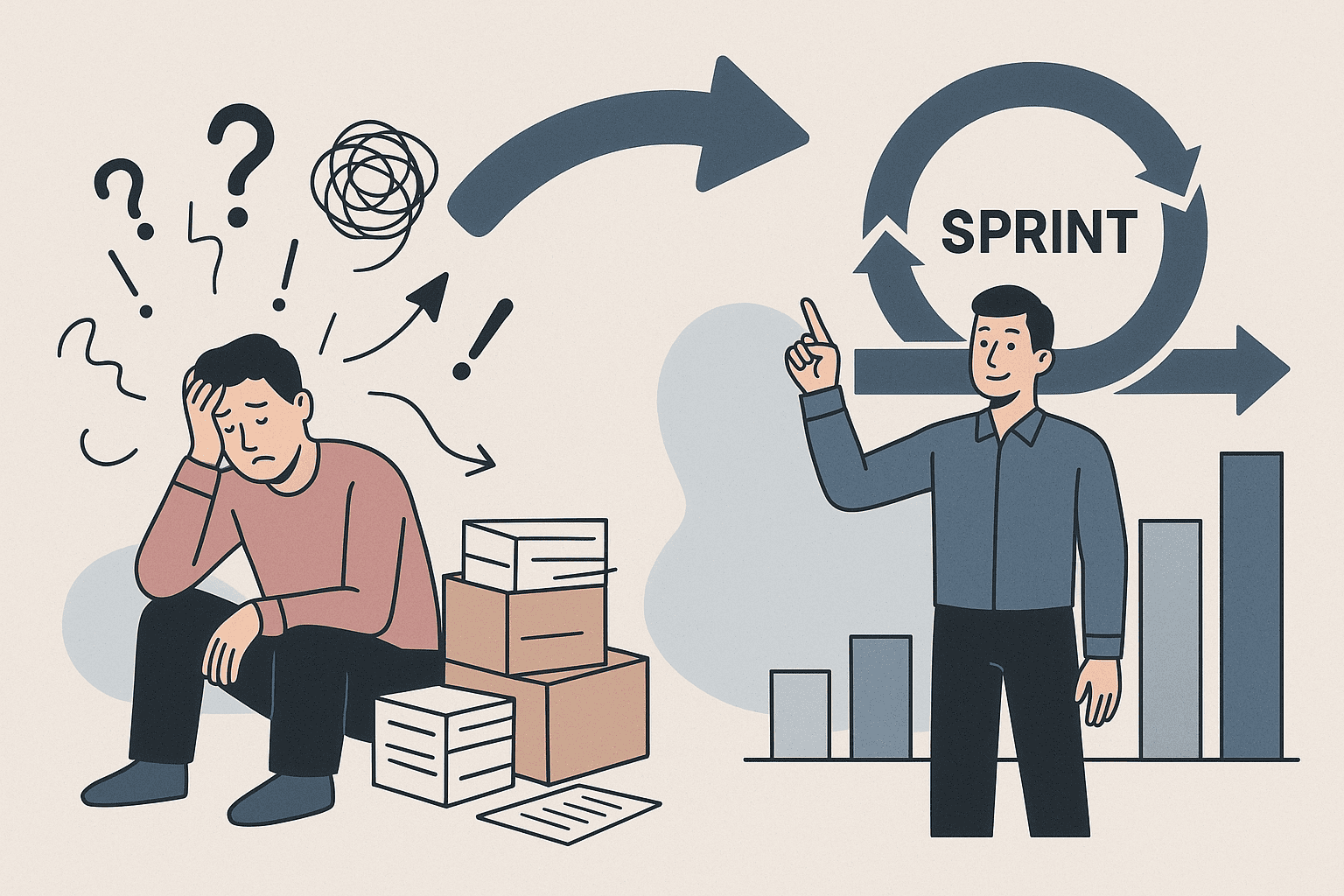The terms ‘I’-shaped and ‘T’-shaped have been buzzwords in relation to recruitment and teamwork for a while. Let’s take a deep dive into how ‘T’-shaped people make Scrum Teams more efficient.
What being ‘T’-shaped really means

A Forbes article explains that “the vertical bar on the letter T represents the depth of your skills and expertise in a single field, whereas the horizontal bar is your breadth or ability to collaborate across disciplines with experts in other areas and apply knowledge to areas beyond your primary field.” So someone who has deep knowledge or skill in one field but also has a wider range of skills or knowledge that can be applied to other verticals or areas of expertise is said to be a ‘T’-shaped person.
Difference between Traditional Teams and Scrum Teams
Let’s first look at how work is done in a traditional team versus how it is done in a Scrum team.
Say, a customer comes in with a requirement for a new video game. The development of a video game usually involves a team of individuals with various responsibilities, including designers, artists, programmers, developers and testers.
Roles in Traditional Teams
In a traditional team, a client manager might take the brief for the new game and pass on the information to a project manager. In smaller firms, client managers often double as project managers.
The project manager would break down the various components that need to come together to build a new game. He/she would then create a step-by-step chart as to how the work would progress over the next few weeks. The focus would be on fixing the scope, cost and schedule of the project. Then the project/client manager assigns the various components to different teams/individuals depending on their skill sets and availability, and coordinates between various teams to ensure that the product, or in this case, the new video game, is completed and delivered to the client on time and within budget.
Traditional Teams Tend to be ‘I’-shaped
A traditional team is comprised of people with similar skill sets, say a team of designers, or a team of programmers. Each individual in these teams would be an expert in their own field but may not have much experience or skills outside of their own domain. For instance, a UI/UX designer need not have experience with coding which is the particular skill of a developer.
The only person in a traditional team who could be ‘T’-shaped is the project manager. While, on the one hand, a project manager needs to have in-depth project management knowledge and experience (deep skills on the vertical line), on the other, they are also expected to coordinate and work with multiple teams and communicate requirements effectively to each team (range of skills on the horizontal line). This requires the project manager to have a wider skill set and a basic understanding of all the various components that go into making a product than an individual from the various teams who report to him/her.
That’s all well and good for the project manager overseeing a project in a traditional Waterfall scenario, but such teams comprised of ‘I’-shaped individuals do not work in the rapidly changing environment of Agile/Scrum.
Problem with ‘I’-shaped Teams
These are some of the issues that traditional teams, which tend to be I-shaped, face.
- Since project managing traditional teams requires a lot of coordination involving different teams, there could potentially be a significant cost involved in terms of the number of man-hours spent in meetings.
- As project components are siloed in traditional project management there is a chance of knowledge loss during project handoff from one department to the next.
- Project managers may be faced with an attitude of “it’s-not-my-job” which could hinder the efficient allocation of resources.
- There is no cross-functional learning and skill development in a traditional project management setup.
Roles in Scrum Teams
Let’s use the same example of a new video game requirement and see how it would work in the Scrum framework.
There are 3 Scrum Roles: a Product Owner, a Scrum Master and 5-9 Scrum Team members who would form the core development team responsible for doing the actual work.
The Product Owner in Scrum represents the key stakeholders and has a deep understanding of the needs of the customer, the users, the market, competitors and trends. They play the role of translating the product requirements into the Product Backlog, or the set of tasks required to complete the product.
The Scrum Master serves the Scrum Team, the Product Owner and the organization in different ways but their main role is that of facilitating the team’s delivery of each incremental iteration of the product by utilizing Scrum best practices. They work from within the team.
Scrum Teams are ‘T’-shaped, by default
A Scrum Team, as per the Scrum Guide, is a self-organizing, cross-functional team. Being self-organizing means that the members of the team themselves decide how the work will be completed, who will do it and how much of the work will be done within a certain timeframe.
Being cross-functional means that the team would be made up of people with different skill sets.
In our example, say the product to be delivered is a new complete video game. The Scrum development team is a self-contained set of people with different skills consisting of designers, artists programmers, testers, analysts and so on. This means that the team would contain all the skills necessary to deliver each incremental iteration of the product – without any inputs from outside the team.
Within the Scrum Team, there is scope for a team member to take on work that he/she may not have trained for or have experience with. Say, if a designer finds some extra time during a particular sprint, they could try to pitch in with some coding or testing work to help the team complete the iteration on schedule.
Benefits of having ‘T’-Shaped Individuals in Scrum Teams
T-shaped individuals tend to possess both deep skills in their particular area of expertise as well as soft skills like teamwork, communication skills, eagerness to learn and time management skills. Hence, their inclusion in a Scrum Team elevates the work of the entire team and increases the efficiency with which they deliver value.
Some of the benefits of having T-shaped members in Scrum Teams are as follows:
- Teams with T-shaped members tend to have better communication and collaboration as opposed to teams with only I-shaped individuals.
- T-shaped team members give the Scrum Team more flexibility in organizing the tasks in a sprint backlog. For instance, if one person in the team falls sick, someone else with cross-functional knowledge could pitch in and help complete the increment on schedule.
- T-shaped employees are able to apply their specialized knowledge and desire to learn to help other team members complete their work and the whole organization in building greater value products for their customers.
It’s not difficult to develop T-shaped skills
In fact, every individual has the potential to be T-shaped. Every individual has the capability to learn more than one skill and to perform well in more than one type of task. And every individual has the ability to coordinate and communicate with those with other areas of expertise; to join forces with them and create efficient T-shaped teams.
Get certified as a Scrum Master and learn how to foster an environment in which people can be free to explore their multi-skilled potential and pool in their different areas of expertise to make the Scrum Team more efficient.



